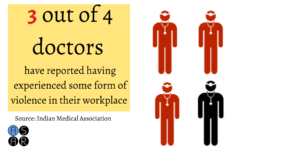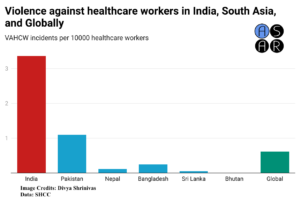We Need Your Help!
Petition on violence against healthcare workers in India
![]()
The World Health Organization (WHO) defines violence against health workers (VAHCW) as “incidents where staff is abused, threatened, or assaulted in circumstances related to their work, including commuting to and from work, involving an explicit or implicit challenge to their safety, well-being, or health”. The term VAHCW is not limited to only doctors but covers all healthcare workers (HCWs) including grassroots workers like ASHAs, community health workers, dais, midwives, nurses, pharmacists, ambulance drivers, emergency medical technicians (EMTs), and auxiliary staff.

VAHCW is rampant in India. Every month, if not every day, there are stories all around the country, one more grave than the other, of HCWs being threatened, harassed, and attacked. For example, in Surat, in March 2022, a nurse was attacked by an emergency ward patient with an iron table and had to get three stitches. The nurse filed an FIR and the person was booked under the Indian Penal Code 332. But there is no further information on any action taken by the hospital or by the police. In January 2022, a community health worker was attacked in Reoti, Bihar. The Reoti Police arrested the person on the charges of breaching peace and altercation. Furthermore, the violence is not restricted to incidents within a hospital. It goes beyond HCWs’ workplace. In Ahmedabad, in March of 2022, an ambulance driver and an EMT were threatened and assaulted while they were out to pick up a patient from a residential society. The patient not only threatened but also attacked them.
These examples form a small part of the Big Statistic.
WHY IS THIS PETITION IMPORTANT
– The physical & psychological abuse of HCWs has reached an all-time high in India. A meta-analysis including 2849 participants from 15 research studies showed that 63% of HCWs experienced some form of violence in their workplace. The prevalence was 64% for male and 54% for female HCWs. The prevalence of verbal violence was 52% while that of physical violence was 8%.

– The concern has only grown since the COVID-19 pandemic. Data from Safeguarding Health in Conflict Coalition (SHCC) shows that the number of HCWs experiencing threats has increased 5 times, those injured have grown almost 1.5 times while assaults have increased by a whopping 3 times in 2020 compared to previous years.

– Based on available data, when compared with other South Asian countries that are not under conflict, India had the highest VAHCW rate during 2017-2021. India’s VAHCW rate was substantially higher than the global rate.

– The incidents reported in the news are often just the tip of the iceberg. Many cases go unreported. Most reported incidents talk only about doctors. But doctors form only a fifth of all HCWs in India. So, violence in the case of the majority of HCWs gets neglected. Data is the key to decision-making.
– Violence has multiple adverse impacts on HCWs. It can result in impaired work functioning, increased stress, job dissatisfaction, and life-threatening injuries. These adverse effects decrease the work performance of HCWs, in turn, impacting patient care.
– There have been several strikes in response to VAHCW incidents. Strikes are usually the last step taken when HCWs are scared to do their job. Strikes lead to hospitals being shut down and stall patient care. The most recent incident which sent chills down everyone’s spine was when a patient killed an intern with a pair of surgical scissors at Kerala’s Kottarakkara Taluk Hospital. This caused an uproar among HCWs demanding a secure work environment and strong legal action against the accused.
We do not blame the patients here. The main takeaway is:
Violence against healthcare workers is a systemic problem. Systemic problems need systemic solutions.
This is where you all come in! Help us by signing this petition and let us eradicate this by the roots!
OUR ASKS
We are not asking for much, we have only two main asks:
Ask for the Central Government
– To pass the ‘The Healthcare Service Personnel and Clinical Establishments (Prohibition of Violence and Damage to Property) Bill (2019)” proposed by the Ministry of Health and Family Welfare (MoHFW). The Home Ministry cited two main reasons for not taking the bill further:
- Health is a state subject.
However, the Centre has intervened in decisions related to health in the past. For example, the Pre-Conception and Pre-Natal Diagnostic Techniques (PCPNDT) Act, 1994 against fetal sex determination tests to fix a widespread problem of female infanticide that existed at the time. The Epidemic Diseases Act (1897) was invoked by the Centre to respond to the growing threat of the COVID-19 pandemic on March 11, 2020. The Epidemic Diseases Ordinance (2020) was passed on April 22, 2020, that amended the Act to recognize any violence against healthcare service personnel as a cognizable and non-bailable offence. While an important step, it was a temporary solution (since the Act can only be in place in case of an epidemic) to a systemic problem. There are key differences between the 2019 MoHFW Bill and the Epidemic Diseases Act. First, the bill was drafted with the help of HCWs. Secondly, the bill properly defines the specific categories of HCWs and institutions thus providing better protection to a wider group of individuals and workplaces against violence and more stringent punishment to the perpetrators. More importantly, the bill can be strengthened further before passing.As per the Parliamentary Bulletin Part II, on 29th July 2022, Pudukkottai MP Shri Tiruchi Siva in Private Members Resolution discussed the need for a Central Law on the issue. Thiruvananthapuram MP, Shashi Tharoor, on 13th Feb 2023, in the Lok Sabha during zero hour advocated for the reintroduction of the 2019 Bill. - Other professionals will make similar demands.
A Right To Information activist and doctor from Kerala filed an RTI request to seek the status of the 2019 bill. The response to the RTI noted that the MoHFW was asked not to pursue the draft because other fraternities would make similar demands. Studies reveal that the likelihood of assaults against HCWs is four times greater than that against professionals in general workplaces, with particular vulnerability among junior doctors and nurses employed in government hospitals. Moreover, in the past, the Centre has passed protective legislation specific to professions (police, armed forces, etc.) and employee groups (such as public servants). For example, the Indian Penal Code (IPC) Section 189 makes threatening a public servant with injury to them punishable by 2 years of imprisonment or fine, or both while Section 333 makes voluntarily causing grievous hurt to deter a public servant from their duty punishable by 10 years of imprisonment and a fine.Even though these sections include HCWs employed in the public sector, it excludes HCWs working in the private sector. 65% of doctors, 89% of dentists, 93% of AYUSH practitioners, and 67% of other HCWs work in the private sector. 60% of inpatient care and 70% of outpatient care in India is provided by the private sector. This is why HCWs, going beyond the public sector, need protection as a group.
Asks for the State Governments
– State-level vigilance councils should be set up for overviewing enforcement of and revisions to existing state laws on VAHCW. An RTI petition filed by the Medicos Legal Action Group in Chandigarh asked police officers of Punjab and Haryana about the perpetrators punished under the Medicare Act and found that not a single person was booked from 2010 to 2015. Moreover, currently, the varied state laws have weak enforcement and 11 states and union territories have no laws at all.
– State-level monitoring cells should be set up to maintain a database on VAHCW incidents and legal proceedings following such incidents including the count of prosecutions. This is important as currently, all VAHCW incidents do not result in FIRs, all FIRs do not lead to court cases, and all court cases do not lead to convictions.
For some states, there have been advocacy efforts for VAHCW. In Maharashtra, the Medico-Legal Society of India has filed a Public Interest Litigation (PIL) in the High Court of Judicature in Bombay asking for amendments to the existing Medicare Service Persons And Medicare Service Institutions (Prevention of Violence and Damage or loss to property) Act. With hearings still ongoing, it will complete two years in July 2023 without any substantive action taken despite the Advocate General of Maharashtra informing the court that a new Act needs to be framed. The Medico-Legal Society of India has requested amendments to the Act in the state of Kerala too. As of 30th March 2023, the Kerala government agreed to frame a new Act and has scheduled proceedings in April of 2023.
WHY PUBLIC SUPPORT MATTERS
Last year in Nepal, healthcare workers and citizens worked together to bring legal and on-ground protections. A public petition finally resulted in Nepal’s President passing an ordinance on the ‘Safety and Security of Health Workers and Health Institutions’ in May 2022. In addition to demanding a legal recourse, we would also like this petition to bring about a positive behavioural change in the community towards HCWs. It is a success story.
When people ask for change, the government has to listen!
Public support is important on this matter!
That’s what will bring the final change!
Sign this petition to ask the government to pass #NewLawNow to protect Indian healthcare workers.
About ASAR
The Association for Socially Applicable Research (ASAR) is a not-for-profit non-governmental organization founded in 2018. It is a unique think-tank and advocacy group with a blend of individuals from various academic disciplines. ASAR aims to create and communicate evidence for informing better policies and influencing meaningful public discourse. It also aims to impart research training to motivated individuals from diverse disciplines.
NOTE: We would like to inform you that the content provided in this blog post is generously contributed by ASAR, a non-profit organization dedicated to the welfare of doctors. MEDILENS Medical and Health News Magazine, the platform hosting this blog, is not responsible for the content itself but is honored to support ASAR in their mission.
